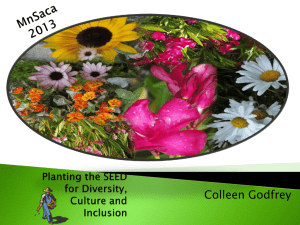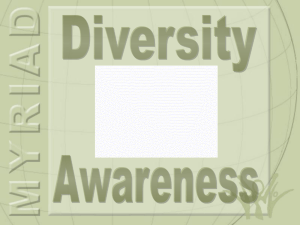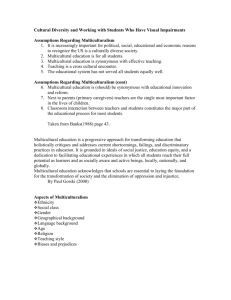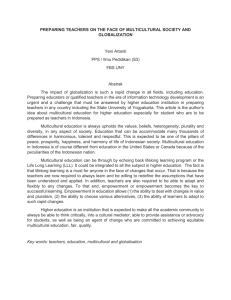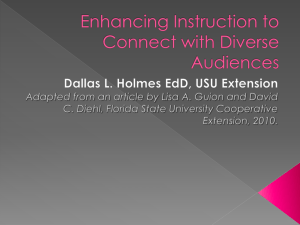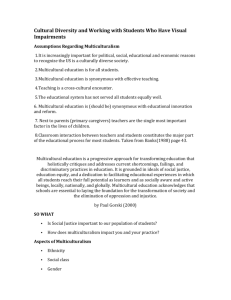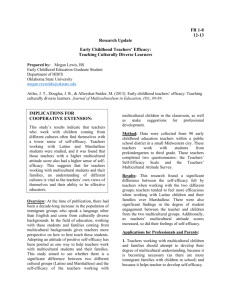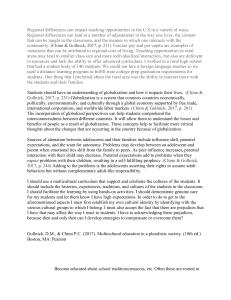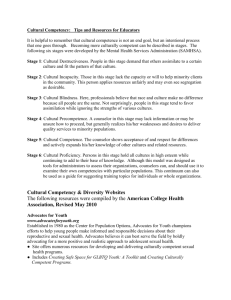EDUC 660
advertisement
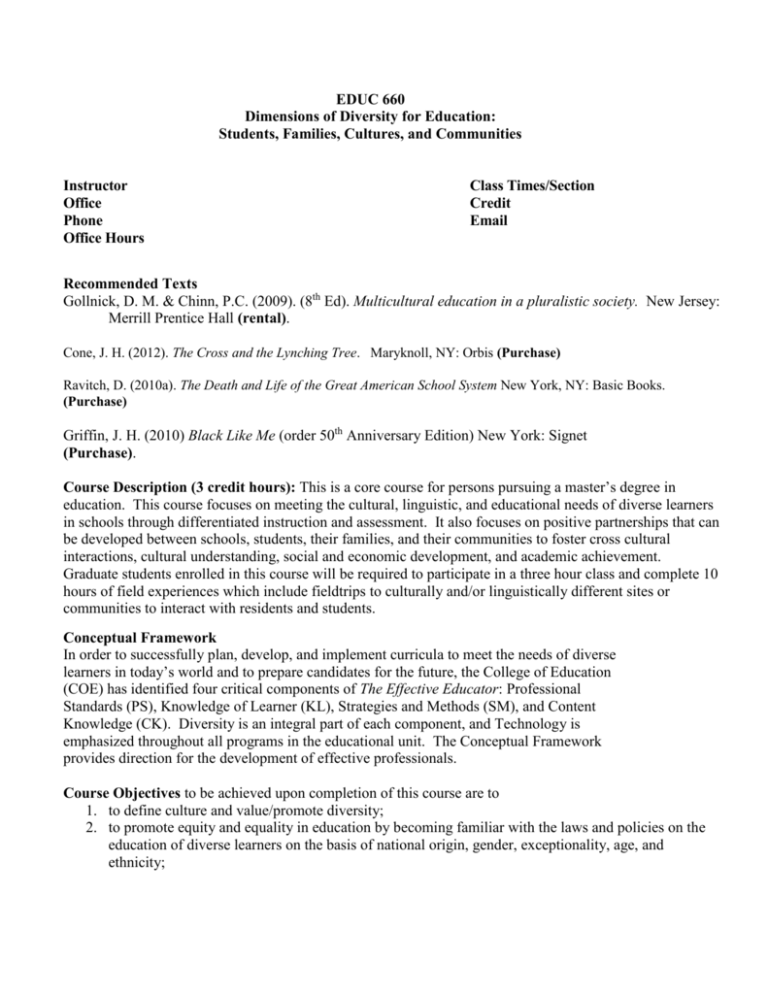
EDUC 660 Dimensions of Diversity for Education: Students, Families, Cultures, and Communities Instructor Office Phone Office Hours Class Times/Section Credit Email Recommended Texts Gollnick, D. M. & Chinn, P.C. (2009). (8th Ed). Multicultural education in a pluralistic society. New Jersey: Merrill Prentice Hall (rental). Cone, J. H. (2012). The Cross and the Lynching Tree. Maryknoll, NY: Orbis (Purchase) Ravitch, D. (2010a). The Death and Life of the Great American School System New York, NY: Basic Books. (Purchase) Griffin, J. H. (2010) Black Like Me (order 50th Anniversary Edition) New York: Signet (Purchase). Course Description (3 credit hours): This is a core course for persons pursuing a master’s degree in education. This course focuses on meeting the cultural, linguistic, and educational needs of diverse learners in schools through differentiated instruction and assessment. It also focuses on positive partnerships that can be developed between schools, students, their families, and their communities to foster cross cultural interactions, cultural understanding, social and economic development, and academic achievement. Graduate students enrolled in this course will be required to participate in a three hour class and complete 10 hours of field experiences which include fieldtrips to culturally and/or linguistically different sites or communities to interact with residents and students. Conceptual Framework In order to successfully plan, develop, and implement curricula to meet the needs of diverse learners in today’s world and to prepare candidates for the future, the College of Education (COE) has identified four critical components of The Effective Educator: Professional Standards (PS), Knowledge of Learner (KL), Strategies and Methods (SM), and Content Knowledge (CK). Diversity is an integral part of each component, and Technology is emphasized throughout all programs in the educational unit. The Conceptual Framework provides direction for the development of effective professionals. Course Objectives to be achieved upon completion of this course are to 1. to define culture and value/promote diversity; 2. to promote equity and equality in education by becoming familiar with the laws and policies on the education of diverse learners on the basis of national origin, gender, exceptionality, age, and ethnicity; 2 3. to explore cultural, social, linguistic, economic, and familial pluralism in communities and their influence on student achievement.; 4. to examine effective partnerships and resources between schools, students, families, and communities; 5. to experience direct interactions with culturally different community members or students; 6. to use differentiated instructional and assessment techniques that address the educational needs of diverse students; and 7. to infuse technology and multicultural activities in lessons to enhance students’ learning. Bibliography Banks, J. (2001). Suggested methods for teaching about racial, ethnic, and cultural diversity and public policies. Cultural Diversity and Education. Foundations, Curriculum and Teaching. Needham Heights, MA 02494: Allyn and Bacon. Banks, J.A., & Banks, C.A.M.(Eds). (1995). Handbook of research on multicultural education. New York: Macmillian. Cummins, J. (2002). Rights and responsibilities of educators of bilingualbicultural children. In L. D. Soto (Ed.), Making a difference in the lives of bilingual-bicultural learners. New York: Peter Lang Publishers. Chamberlain, S., Guerra, P., & Garcia, S. (1999). Intercultural communication in the classroom. Austin, TX: Southwest Educational Development Laboratory. Davis, C., Kea, C., & Trent, S. (2002). African American student teachers’ perceptions about preparedness to teach students from culturally and linguistically diverse backgrounds. Multicultural Perspectives, 4 (1), 18-25. Epstein, J. L. (2001). School, family, and community partnerships: Preparing educators and improving schools. Boulder, CO: Westview. Fishman, J. (1989). Language and ethnicity in minority sociolinguistic perspective. Clevedon, England: Multilingual Matters. Gay, G. (2000). Culturally responsive teaching: Theory, research, and practice. New York: Teachers College Press. Gollnick, D. M. & Chinn, P.C. (2004). (6th Ed). Multicultural education in a pluralistic society. New Jersey: Merrill Prentice Hall Kenneth M. Johns and Nena Torrez, Helping ESL Learners Succeed (Phi Delta Kappa Educational Foundation, Bloomington, Indiana, 2001). Kirylo, J. (2006). Working with a diverse student population: The mission is not to save, but to reflectively teach. NCPEA Connexions. Retrieved October 23, 2006 from http://cnx.org/content/m14073/latest/ 3 Kirylo, J. D., & Nauman, A. (2006). The depersonalization of education and the language of accountability: A view from a local newspaper. Journal of Curriculum and Pedagogy, (3)1, 187-206. Kirylo, J. (2006). Preferential Option for the Poor: Making a Pedagogical Choice. Childhood Education,82(5), 266-270 (Annual Theme Issue). Kirylo, J (Winter 2005/2006). Lessons: Katrina and Beginning Anew. Childhood Education,82(2), 95-97. Kirylo, J. (2005). The Seduction of Being Entrenched in the Circuit of Our Own Truth and the Antidote of Humility Journal of Curriculum and Pedagogy, (2)2, 28-30. Kirylo, J. (2005). Separation of Church and State and Public Schools: A Guide for Parents. Association for Childhood International (ACEI SPEAKS Brochure). Kirylo, J.D. (2001, Spring). A historical overview of liberation theology: Some implications for the Christian educator. Journal of Research on Christian Education, 10(1), 53-86. Kirylo, J. (1999). The discourse of the spirituality of liberation theology in curriculum theory. Journal of Curriculum Theorizing, 15(1), 77-87. Lindsey, R., Robins, K., Terrell, R. (2003). Overcoming the barrier to cultural proficiency. Cultural Proficiency. A manual for school leaders. California: Corwin Press, Inc. Nieto, S. (1999). In the light of their eyes: Creating multicultural learning communities. New York: Teachers College Press. Pang, V. (2001). How can I make the curriculum culturally meaningful?. Multicultural Education. New York: McGraw-Hill.
